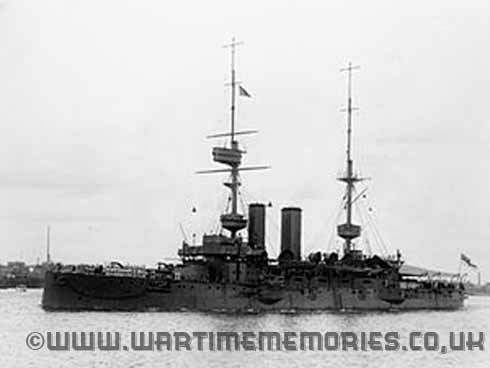14th Nov 1914 Ready for any Invasion
26th Nov 1914 HMS Bulwark lost 
HMS Bulwark
A powerful internal explosion ripped HMS Bulwark apart at 0750 on 26 November 1914 while she was moored at Number 17 buoy in Kethole Reach, 4 nmi (4.6 mi; 7.4 km) west of Sheerness in the estuary of the River Medway. Out of her complement of 750, no officers and only 14 sailors survived, two of whom subsequently died of their injuries in hospital. Most of the survivors were seriously injured.
The only men to survive the explosion comparatively unscathed were those who had been in Number 1 mess-deck amidships, who were blown out of an open hatch. One of these men, Able Seaman Stephen Marshall, described feeling the sensation of "a colossal draught", being drawn "irresistibly upwards", and, as he rose in the air, clearly seeing the ship's masts shaking violently.
Witnesses on the battleship Implacable, the next ship in line at the mooring, reported that "a huge pillar of black cloud belched upwards. From the depths of this writhing column flames appeared running down to sea level. The appearance of this dreadful phenomenon was followed by a thunderous roar. Then came a series of lesser detonations, and finally one vast explosion that shook the Implacable from mastheads to keel."
The destruction of Bulwark was also witnessed on board battleship Formidable, where "when the dust and wreckage had finally settled a limp object was seen hanging from the wireless aerials upon which it had fallen. With difficulty the object was retrieved and found to be an officer's uniform jacket with three gold bands on the sleeves and between them the purple cloth of an engineer officer. The garment's former owner had been blasted into fragments."
Perhaps the most detailed descriptions of the disaster came from witnesses on board battleships Prince of Wales and Agamemnon, both of whom stated that smoke issued from the stern of the ship prior to the explosion and that the first explosion appeared to take place in an after magazine.
On 29 November 1914 divers sent to find the wreck reported that the ship's port bow as far aft as the sick bay had been blown off by the explosion and lay 50 ft (15 m) east of the mooring. The starboard bow lay 30 ft (9.1 m) further away. The remainder of the ship had been torn apart so violently that no other large portions of the wreck could be found.
In terms of loss of life, the incident remains the second most catastrophic accidental explosion in the history of the United Kingdom, exceeded only by the explosion of the dreadnought battleship Vanguard, caused by a stokehold fire detonating a magazine, at Scapa Flow in 1917.
Inquiry into loss
A naval court of enquiry into the causes of the explosion held on 28 November 1914 established that it had been the practice to store ammunition for Bulwark's 6 in (150 mm) guns in cross-passageways connecting her total of 11 magazines. It suggested that, contrary to regulations, 275 six-inch shells had been placed close together, most touching each other, and some touching the walls of the magazine, on the morning of the explosion.
The most likely cause of the disaster appears to have been overheating of cordite charges stored alongside a boiler room bulkhead, and this was the explanation accepted by the court of enquiry. It has also been suggested that damage caused to one of the shells stored in the battleship's cross-passageways may have weakened the fusing mechanism and caused the shell to become 'live'. A blow to the shell, caused by it being dropped point down, could then have set off a chain reaction of explosions among the shells stored in Bulwark's cross-passageways sufficient to detonate the ship's magazines.
Memorials
A memorial to those lost on Bulwark and Princess Irene was erected at the Dockyard Church, Sheerness in 1921. It was dedicated by Archdeacon Ingles, the Chaplain of the Fleet. It was unveiled by Hugh Evan-Thomas, Commander-in-Chief, The Nore. Victims of both ships are also commemorated on the Naval War Memorial at Southsea. Another memorial was placed in Woodlands Road Cemetery, Gillingham, as part of the Naval Burial Ground.
John Doran
If you can provide any additional information, please add it here.





